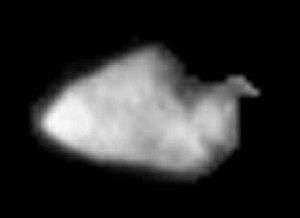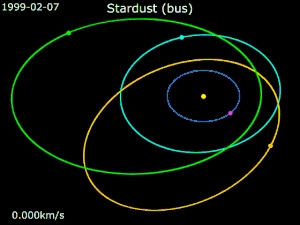5535 Annefrank
5535 Annefrank (/ˌænˈfræŋk/), provisional designation 1942 EM, is a stony Florian asteroid and suspected contact binary from the inner asteroid belt, approximately 4.5 kilometers in diameter. It was used as a target to practice the flyby technique that the Stardust space probe would later use on the comet Wild 2.[8]
 Annefrank viewed by Stardust in 2002 | |
| Discovery [1] | |
|---|---|
| Discovered by | Karl Wilhelm Reinmuth |
| Discovery site | Heidelberg Obs. |
| Discovery date | 23 March 1942 |
| Designations | |
| (5535) Annefrank | |
Named after | Anne Frank (Holocaust victim)[2] |
| 1942 EM · 1978 EK6 1986 TV14 · 1991 BO2 | |
| main-belt · Flora [3] | |
| Orbital characteristics [1] | |
| Epoch 4 September 2017 (JD 2458000.5) | |
| Uncertainty parameter 0 | |
| Observation arc | 75.02 yr (27,400 days) |
| Aphelion | 2.3527 AU |
| Perihelion | 2.0721 AU |
| 2.2124 AU | |
| Eccentricity | 0.0634 |
| 3.29 yr (1,202 days) | |
| 23.021° | |
| 0° 17m 58.2s / day | |
| Inclination | 4.2473° |
| 120.64° | |
| 9.1351° | |
| Physical characteristics | |
| Dimensions | (6.6 x 5.0 x 3.4 km)[1] 4.34±0.23 km[4] 4.8 km[1] 4.94 km (calculated)[3] |
| 15.12 h[5] 15.156±0.0474 h[6] 21.33±0.990 h[7] | |
| 0.21±0.03[8] 0.24 (assumed)[3] 0.279±0.092[9] 0.311±0.056[4] | |
| S [3][8] | |
| 13.650±0.120 (R)[7] · 13.679±0.001 (R)[6] · 13.7[1][3][4] · 13.88±0.32[10] | |
The asteroid was discovered 23 March 1942, by German astronomer Karl Reinmuth at Heidelberg Observatory in southwest Germany.[11] It was named after Anne Frank, a victim of the Holocaust.[2]
Orbit and classification
Annefrank is a member of the Flora family, one of the largest collisional populations of stony asteroids in the main-belt. It orbits the Sun in the inner main-belt at a distance of 2.1–2.4 AU once every 3 years and 3 months (1,202 days). Its orbit has an eccentricity of 0.06 and an inclination of 4° with respect to the ecliptic.[1]
The body's observation arc begins at Crimea–Nauchnij in 1978, with its identification as 1978 EK6, 36 years after its official discovery observation at Heidelberg.[11]
Physical characteristics
Annefrank has been characterized as a common S-type asteroid.[3][8]
Diameter, albedo and shape
On 2 November 2002, the Stardust space probe flew past Annefrank at a distance of 3079 km. Its images show the asteroid to be 6.6 × 5.0 × 3.4 km, twice as big as previously thought, and its main body shaped like a triangular prism with several visible impact craters.[8] From the photographs, the albedo of Annefrank was computed to be between 0.18 and 0.24.[8] Preliminary analysis of the Stardust imagery suggests that Annefrank may be a contact binary, although other possible explanations exist for its observed shape.[8]
Rotation and poles
In October 2006, ground-based photometric observations were used in an attempt to measure Annefrank's rotational period. Analysis of the ambiguous lightcurve gave a period of 15.12 hours and a brightness variation of 0.25 magnitude with two alternative period solutions of 12 and 22.8 hours, respectively (U=2).[3][5]
In January 2014, photometric observations at the Palomar Transient Factory gave a rotation period of 15.156 and 21.33 hours with an amplitude of 0.17 and 0.20 magnitude, respectively (U=2/2).[6][7]
The lightcurve data suggests that Annefrank is not Lambertian, meaning that surface features, such as shadows from boulders and craters, play a role in the object's perceived brightness and not just the asteroid's relative size when seen from that orientation.[5]
The body's shortest axis is approximately aligned perpendicular to its orbital plane.[8]
Naming
This minor planet was named after Anne Frank, the Dutch-Jewish diarist who died in a Nazi concentration camp (World War II).[2] The official naming citation was published by the Minor Planet Center on 14 May 1995 (M.P.C. 25230).[12]
References
- "JPL Small-Body Database Browser: 5535 Annefrank (1942 EM)" (2017-03-29 last obs.). Jet Propulsion Laboratory. Retrieved 22 June 2017.
- Schmadel, Lutz D. (2007). "(5535) Annefrank". Dictionary of Minor Planet Names – (5535) Annefrank. Springer Berlin Heidelberg. p. 472. doi:10.1007/978-3-540-29925-7_5280. ISBN 978-3-540-00238-3.
- "LCDB Data for (5535) Annefrank". Asteroid Lightcurve Database (LCDB). Retrieved 20 March 2017.
- Masiero, Joseph R.; Mainzer, A. K.; Grav, T.; Bauer, J. M.; Cutri, R. M.; Nugent, C.; et al. (November 2012). "Preliminary Analysis of WISE/NEOWISE 3-Band Cryogenic and Post-cryogenic Observations of Main Belt Asteroids". The Astrophysical Journal Letters. 759 (1): 5. arXiv:1209.5794. Bibcode:2012ApJ...759L...8M. doi:10.1088/2041-8205/759/1/L8. Retrieved 20 March 2017.
- Schmidt, B. E.; Bauer, J.; Buratti, B. J.; Russell, C. T. (March 2007). "Rotational Light Curve and Rotation Period of 5535 Annefrank" (PDF). 38th Lunar and Planetary Science Conference (1338): 1859. Bibcode:2007LPI....38.1859S. Retrieved 20 March 2017.
- Waszczak, Adam; Chang, Chan-Kao; Ofek, Eran O.; Laher, Russ; Masci, Frank; Levitan, David; et al. (September 2015). "Asteroid Light Curves from the Palomar Transient Factory Survey: Rotation Periods and Phase Functions from Sparse Photometry". The Astronomical Journal. 150 (3): 35. arXiv:1504.04041. Bibcode:2015AJ....150...75W. doi:10.1088/0004-6256/150/3/75. Retrieved 20 March 2017.
- Chang, Chan-Kao; Ip, Wing-Huen; Lin, Hsing-Wen; Cheng, Yu-Chi; Ngeow, Chow-Choong; Yang, Ting-Chang; et al. (August 2015). "Asteroid Spin-rate Study Using the Intermediate Palomar Transient Factory". The Astrophysical Journal Supplement Series. 219 (2): 19. arXiv:1506.08493. Bibcode:2015ApJS..219...27C. doi:10.1088/0067-0049/219/2/27. Retrieved 20 March 2017.
- Duxbury, Thomas C.; Newburn, Ray L.; Acton, Charles H.; Carranza, Eric; McElrath, Timothy P.; Ryan, Robert E.; et al. (February 2004). "Asteroid 5535 Annefrank size, shape, and orientation: Stardust first results" (PDF). Journal of Geophysical Research. 109 (E2): E02002. Bibcode:2004JGRE..109.2002D. doi:10.1029/2003JE002108. Retrieved 22 June 2017.
- Hillier, John K.; Bauer, James M.; Buratti, Bonnie J. (January 2011). "Photometric modeling of Asteroid 5535 Annefrank from Stardust observations". Icarus. 211 (1): 546–552. Bibcode:2011Icar..211..546H. doi:10.1016/j.icarus.2010.10.009. Retrieved 20 March 2017.
- Veres, Peter; Jedicke, Robert; Fitzsimmons, Alan; Denneau, Larry; Granvik, Mikael; Bolin, Bryce; et al. (November 2015). "Absolute magnitudes and slope parameters for 250,000 asteroids observed by Pan-STARRS PS1 - Preliminary results". Icarus. 261: 34–47. arXiv:1506.00762. Bibcode:2015Icar..261...34V. doi:10.1016/j.icarus.2015.08.007. Retrieved 20 March 2017.
- "5535 Annefrank (1942 EM)". Minor Planet Center. Retrieved 20 March 2017.
- "MPC/MPO/MPS Archive". Minor Planet Center. Retrieved 20 March 2017.
External links
| Wikimedia Commons has media related to 5535 Annefrank. |
- A page with images from the Stardust flyby
- Ted Stryk's Stardust page, including enhanced images of 5535 Annefrank
- Asteroid Lightcurve Database (LCDB), query form (info)
- Dictionary of Minor Planet Names, Google books
- Asteroids and comets rotation curves, CdR – Observatoire de Genève, Raoul Behrend
- Discovery Circumstances: Numbered Minor Planets (5001)-(10000) – Minor Planet Center
- 5535 Annefrank at the JPL Small-Body Database

